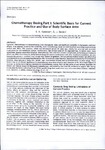Chemotherapy Dosing Part I: Scientific Basis for Current Practice and Use of Body Surface Area
| dc.contributor.author | Sewell, GJ | |
| dc.contributor.author | Kaestner, S | |
| dc.date.accessioned | 2015-10-27T16:25:18Z | |
| dc.date.available | 2015-10-27T16:25:18Z | |
| dc.date.issued | 2007 | |
| dc.identifier.issn | 0936-6555 | |
| dc.identifier.issn | 1433-2981 | |
| dc.identifier.uri | http://hdl.handle.net/10026.1/3714 | |
| dc.description.abstract |
Cytotoxic chemotherapy is characterised by a low therapeutic index and significant variability in therapeutic and toxic effects. In an attempt to reduce this variability, most chemotherapy doses are individualised according to patient body surface area (BSA). This practice, which was introduced almost 50 years ago, clearly has practical and economic implications for the healthcare system. Furthermore, the clinical value of this approach has, in recent years, been questioned. Despite established practice, chemotherapy dose selection remains complicated, partly because treatment effects are difficult to measure, partly because drugs are used in combination with other treatment modalities, and also because the patient's condition may change with disease progression. Various patient-related factors can affect drug pharmacokinetics (PK) and pharmacodynamics (PD), for example organ function, expression and activity of metabolising enzymes, drug resistance, body size, gender, age, concomitant disease and co-administration of other drugs. These factors may be of clinical significance in chemotherapy dose determination and measures of PK, PD or both feature in attempts to devise more rigorous methods for chemotherapy dosing. Part I of this series of two reviews describes the history and clinical impact of BSA-based chemotherapy, and examines the scientific evidence to support BSA dosing. It evaluates the factors affecting PK and PD for specific drugs that could inform and refine dose determination. | |
| dc.format.extent | 23-37 | |
| dc.format.medium | ||
| dc.language | en | |
| dc.language.iso | en | |
| dc.publisher | Elsevier BV | |
| dc.subject | Antineoplastic Agents | |
| dc.subject | Body Surface Area | |
| dc.subject | Humans | |
| dc.subject | Neoplasms | |
| dc.title | Chemotherapy Dosing Part I: Scientific Basis for Current Practice and Use of Body Surface Area | |
| dc.type | journal-article | |
| dc.type | Review | |
| plymouth.author-url | https://www.ncbi.nlm.nih.gov/pubmed/17305252 | |
| plymouth.issue | 1 | |
| plymouth.volume | 19 | |
| plymouth.publication-status | Published | |
| plymouth.journal | Clinical Oncology | |
| dc.identifier.doi | 10.1016/j.clon.2006.10.010 | |
| plymouth.organisational-group | /Plymouth | |
| plymouth.organisational-group | /Plymouth/Faculty of Health | |
| plymouth.organisational-group | /Plymouth/REF 2021 Researchers by UoA | |
| plymouth.organisational-group | /Plymouth/REF 2021 Researchers by UoA/UoA03 Allied Health Professions, Dentistry, Nursing and Pharmacy | |
| plymouth.organisational-group | /Plymouth/REF 2021 Researchers by UoA/UoA03 Allied Health Professions, Dentistry, Nursing and Pharmacy/UoA03 Allied Health Professions, Dentistry, Nursing and Pharmacy MANUAL | |
| plymouth.organisational-group | /Plymouth/Research Groups | |
| plymouth.organisational-group | /Plymouth/Research Groups/Institute of Health and Community | |
| plymouth.organisational-group | /Plymouth/Users by role | |
| dc.publisher.place | England | |
| dc.identifier.eissn | 1433-2981 | |
| dc.rights.embargoperiod | Not known | |
| rioxxterms.versionofrecord | 10.1016/j.clon.2006.10.010 | |
| rioxxterms.licenseref.uri | http://www.rioxx.net/licenses/all-rights-reserved | |
| rioxxterms.type | Journal Article/Review |


